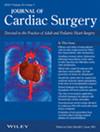Advantages of combined distal-first and visceral branch-first technique: A universal fit for extensive thoracoabdominal aortic aneurysm?
IF 1.3
4区 医学
Q3 CARDIAC & CARDIOVASCULAR SYSTEMS
引用次数: 0
Abstract
Minimization of end ‐ organ ischemia is a key tenet in successful thoracoabdominal aortic aneurysm (TAAA) surgery. In recent years various techniques have been inspired and refined to reduce the duration and risk of visceral ischemia such as mild, moderate, or deep hypothermic repair with left heart bypass, or complete or partial cardiopulmonary bypass combined with selective perfusions to vital viscera, the lower extremities, and the spinal cord. 1 – 3 Despite advances in surgical technique and organ protection strategies, open surgical repair for TAAA remains associated with considerable levels of morbidity and mortality. Moulakakis and colleagues conducted a meta ‐ analysis that summarized the surgical outcomes of 9963 patients in experienced surgical centers and found that the mortality after repair of extent I – IV TAAA was 11.3%. 4 These results can be attributed to the nature of open surgical repair of TAAA, which represents the pinnacle of invasive cardiovascular surgery and comes with the burden of a relatively high association of comorbidities. Estrera et al. reported the “ distal first approach ” assumes the advantage of providing a distal fenestration and ensuring adequate antegrade blood flow at an early stage for patients with chronic aortic dissection. 5 Previous reports have described the utility of “ visceral branch ‐ first techniques ” in reducing visceral ischemic time with minimal reperfusion injury. 6,7 Marchenko et al. also successfully devised a novel “ iliac branch first ”远端优先与内脏分支优先联合技术的优势:广泛胸腹主动脉瘤的普遍适用?
本文章由计算机程序翻译,如有差异,请以英文原文为准。
求助全文
约1分钟内获得全文
求助全文
来源期刊
CiteScore
2.90
自引率
12.50%
发文量
976
审稿时长
3-8 weeks
期刊介绍:
Journal of Cardiac Surgery (JCS) is a peer-reviewed journal devoted to contemporary surgical treatment of cardiac disease. Renown for its detailed "how to" methods, JCS''s well-illustrated, concise technical articles, critical reviews and commentaries are highly valued by dedicated readers worldwide.
With Editor-in-Chief Harold Lazar, MD and an internationally prominent editorial board, JCS continues its 20-year history as an important professional resource. Editorial coverage includes biologic support, mechanical cardiac assist and/or replacement and surgical techniques, and features current material on topics such as OPCAB surgery, stented and stentless valves, endovascular stent placement, atrial fibrillation, transplantation, percutaneous valve repair/replacement, left ventricular restoration surgery, immunobiology, and bridges to transplant and recovery.
In addition, special sections (Images in Cardiac Surgery, Cardiac Regeneration) and historical reviews stimulate reader interest. The journal also routinely publishes proceedings of important international symposia in a timely manner.

 求助内容:
求助内容: 应助结果提醒方式:
应助结果提醒方式:


